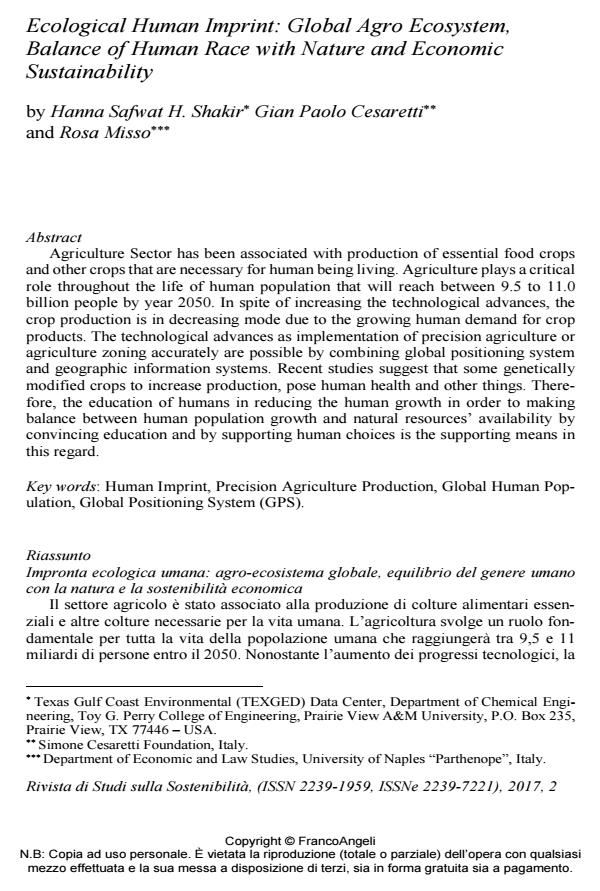Ecological Human Imprint: Global Agro Ecosystem, Balance of Human Race with Nature and Economic Sustainability
Titolo Rivista RIVISTA DI STUDI SULLA SOSTENIBILITA'
Autori/Curatori Hanna Safwat H. Shakir, Gian Paolo Cesaretti, Rosa Misso
Anno di pubblicazione 2017 Fascicolo 2017/2
Lingua Inglese Numero pagine 24 P. 7-30 Dimensione file 256 KB
DOI 10.3280/RISS2017-002002
Il DOI è il codice a barre della proprietà intellettuale: per saperne di più
clicca qui
Qui sotto puoi vedere in anteprima la prima pagina di questo articolo.
Se questo articolo ti interessa, lo puoi acquistare (e scaricare in formato pdf) seguendo le facili indicazioni per acquistare il download credit. Acquista Download Credits per scaricare questo Articolo in formato PDF

FrancoAngeli è membro della Publishers International Linking Association, Inc (PILA)associazione indipendente e non profit per facilitare (attraverso i servizi tecnologici implementati da CrossRef.org) l’accesso degli studiosi ai contenuti digitali nelle pubblicazioni professionali e scientifiche
Agriculture Sector has been associated with production of essential food crops and other crops that are necessary for human being living. Agriculture plays a critical role throughout the life of human population that will reach between 9.5 to 11.0 billion people by year 2050. In spite of increasing the technological advances, the crop production is in decreasing mode due to the growing human demand for crop products. The technological advances as implementation of precision agriculture or agriculture zoning accurately are possible by combining global positioning system and geographic information systems. Recent studies suggest that some genetically modified crops to increase production, pose human health and other things. Therefore, the education of humans in reducing the human growth in order to making balance between human population growth and natural resources’ availability by convincing education and by supporting human choices is the supporting means in this regard.
Impronta ecologica umana: agro-ecosistema globale, equilibrio del genere umano con la natura e la sostenibilità economica. Il settore agricolo è stato associato alla produzione di colture alimentari essen-ziali e altre colture necessarie per la vita umana. L’agricoltura svolge un ruolo fon-damentale per tutta la vita della popolazione umana che raggiungerà tra 9,5 e 11 miliardi di persone entro il 2050. Nonostante l’aumento dei progressi tecnologici, la produzione agricola è in diminuzione a causa della crescente domanda umana di prodotti vegetali. I progressi tecnologici come implementazione accurata dell’agricoltura di precisione o della zonizzazione dell’agricoltura sono possibili combinando sistema di posizionamento globale e sistemi di informazione geografica. Recenti studi suggeriscono che alcune colture geneticamente modificate per aumentare la produzione, impattano sulla salute umana e altre cose. Pertanto, l’educazione degli esseri umani nel ridurre la crescita demografica, al fine di bilanciare popolazione e disponibilità di risorse naturali, è la strategia più appropriata.
Parole chiave:Impronta umana, produzione di agricoltura di precisione, popola-zione umana globale, sistema di posizionamento globale (GPS).
- Ecological human imprint: Agroecosystem in Egypt analysis and perspective Safwat H. Shakir Hanna, Gian Paolo Cesaretti, in RIVISTA DI STUDI SULLA SOSTENIBILITA' 2/2023 pp.41
DOI: 10.3280/RISS2022-002004
Hanna Safwat H. Shakir, Gian Paolo Cesaretti, Rosa Misso, Ecological Human Imprint: Global Agro Ecosystem, Balance of Human Race with Nature and Economic Sustainability in "RIVISTA DI STUDI SULLA SOSTENIBILITA'" 2/2017, pp 7-30, DOI: 10.3280/RISS2017-002002